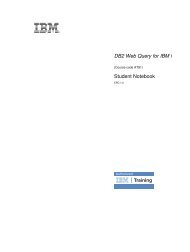IBM Web Content Manager - The IBM Learner Portal is currently ...
IBM Web Content Manager - The IBM Learner Portal is currently ...
IBM Web Content Manager - The IBM Learner Portal is currently ...
You also want an ePaper? Increase the reach of your titles
YUMPU automatically turns print PDFs into web optimized ePapers that Google loves.
<strong>Web</strong> content portlets<br />
<strong>The</strong> following portlets are used in a <strong>IBM</strong> <strong>Web</strong> <strong>Content</strong> <strong>Manager</strong> system.<br />
Portlet type<br />
<strong>Web</strong> content authoring<br />
portlet<br />
<strong>Web</strong> content viewer portlets<br />
Admin<strong>is</strong>tration portlet<br />
Details<br />
<strong>The</strong> authoring portlet <strong>is</strong> used to create and manage web content items.<br />
<strong>Web</strong> content viewer portlets are used to deliver web content within <strong>Portal</strong> pages.<br />
<strong>The</strong> admin<strong>is</strong>tration portlet <strong>is</strong> used to create and manage web content libraries, define<br />
and manage syndication relationships, and define and manage <strong>Web</strong> <strong>Content</strong><br />
Integrator feeds.<br />
<strong>Web</strong> content libraries<br />
A web content library <strong>is</strong> used to store a set of web content items. You assign library-level access controls<br />
to determine the default level of access to the items in the library and define the default access to the<br />
authoring portlet of different users and groups.<br />
Elements<br />
Elements either store web content or generate web content. Elements do not ex<strong>is</strong>t as free-standing items.<br />
You store elements in container web content items. For example, menu and navigator elements are used to<br />
generate links between web pages. HTML and rich text elements are used to store HTML. Some element<br />
types can be stored in site areas, content items, and components. Others can only be stored as<br />
components.<br />
Item types<br />
Items can be considered as files or documents and are used to store web content, metadata, and access<br />
control information.<br />
Item type Examples Details<br />
Container items<br />
Folders<br />
Template items<br />
Site areas, content<br />
items, and<br />
components<br />
Authoring templates<br />
and presentation<br />
templates<br />
Site areas and content items represent different sections of a site<br />
framework. You can store more than one element in site areas and<br />
content items. Components store a single element type.<br />
Folders are used to group sets of item types within the different<br />
item type views in the authoring portlet.<br />
When you create a new content item, you must first select an<br />
authoring template.<br />
Accompanying guide for SPVC - not for d<strong>is</strong>tribution<br />
An authoring templates defines:<br />
v Which data entry fields are v<strong>is</strong>ible on a content item form<br />
v <strong>The</strong> default values for each setting and field on a content item<br />
form<br />
A presentation template defines:<br />
v <strong>The</strong> layout of elements and components that are d<strong>is</strong>played on a<br />
web page<br />
v <strong>The</strong> default properties of a web page<br />
When a content item <strong>is</strong> rendered, the presentation template used to<br />
d<strong>is</strong>play the content item <strong>is</strong> determined by the current template<br />
map. A template map <strong>is</strong> defined in a site area and cons<strong>is</strong>ts of a<br />
pairing of an authoring template with a presentation template.<br />
1: Getting started 7



